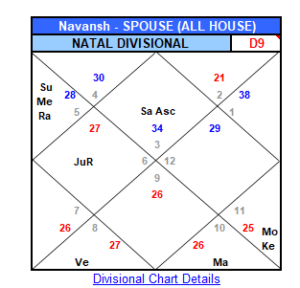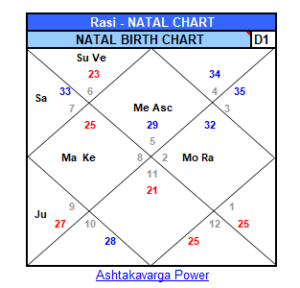NADI ASTROLOGY
NADI ASTROLOGY
S E C R E T O F N A D I A N S H A
I want to be more simple defining secret of nadis, their numbers and degrees in the Shodasa vargas (sixteen subdivision of a sign). Looks easy in calculation but difficult to apply practically. Nadi amsa is the 150th division of an ascendant. Ascendants rise for 100–120 minutes. The shorter ones, rise for about 40–60 minutes, depending upon the savodya kaal, means time span of a rasi. Hence, the 30 degrees of rashi divided by 150 is 12 minutes of arc. On an average, if 2 hours duration is taken for each rashi, it amounts to 48 seconds in time duration (2 hours multiplied by 3600 and divided by 150 is equal to 48 seconds). So 12 min of an arc and 48 sec is one nadiamsa.
INDIAN ASTROLOGY – IMPORTANCE OF NADI
A nadi is a vedic and specific unit of time. It is so short that no two individuals are born in the same nadi, if they are by any chance, they have very similar lives. So, nadi ansha becomes incredibly accurate as it highly distinguishes each individual. The method of nadi ansha is enough to give significant details about the life trajectory of a person along with their identifying features. Coupled with the houses and signs, the nadiamsa technique becomes capable of giving astonishing details. The nadi anshas are numbered in clockwise direction in moveable rasi’s (aries, cancer, libra and capricorn signs) from beginning to end of rashi. In fixed rasi’s (tauras, leo, scorpio, aquarius signs) they begin from end to beginning of rashi anti-clockwise. In dual rashis (gemini, virgo, sagittarius, pisces signs) they begin from middle of rashi, to the end of rashi then continue from beginning of rashi and counted upto the middle of rashi. Role of nadi in predictive astrology is same as of DNA in biological life.
30°/7 30°/16 30°/1, 30°/2, 30°/3, 30°/4, 30°/12, 30°/24 30°/9, 30°/27 30°/10, 30°/20 30°/45 30°/30, 30°/60
The above consist seven groups. Taking last one in each group as favourite, which covers all sub-divisions in it’s group. Let us list them individually.
Saptamsa D-7 (30°/7) 0° => 4°:17’, 8°:34’, 12°:51’, 17°:08’, 21°:25’, 25°:42’, 30°:00’
Shodasansha D-16 (30°/16) 0° => 1°:52’:30”, 3°:45’, 5°:37’:30”, 7°:30’, 9°:22’:30”, 11°:45’, 13°:17’:30”, 15°:00’, 16°:52’:30”, 18°:45’, 20°:37’:30”, 22°:30’; 24°:22’:30”, 26°:15’, 28°:17’:30”, 30°:00’
Chaturvimshansha D-24 (30°/24) 0° => 1°:15’, 2°:30’, 3°:45’, 5°:00’, 6°:15’, 7°:30’, 8°:45’, 10°:00’, 11°:15’, 12°:30’, 13°:45’, 15°:00’; 16°:15’, 17°:30’, 18°:45’, 20°:00’, 21°:15’, 22°:30’, 23°:45’, 25°:00’, 26°:15’, 27°:30’, 28°:45’, 30°:00’
Bhansh D-27 (30°/27) 0° => 1°:06’:40”, 2°:13’:20”, 3°:20’:00”, 4°:26’:40”, 5°:33’:20”, 6°:40’:00”, 7°:46’:40”, 8°:53’:20”, 10°:00’:00”, 11°:06’:40”, 12°:13’:20”, 13°:20’:00”, 14°:26’:40”, 15°:33’:20”, 16°:40’:00”, 17°:46’:40”, 18°:53’:20”, 20°:00’:00”, 21°:06’:40”, 22°:13’:20”, 23°:20’:00”, 24°:26’:40”, 25°:33’:20”, 26°:40’:00”, 27°:46’:40”, 28°:53’:20”, 30°:00’:00”
Khavedansha D-40 (30°/40) 0° 0°:45’, 1°:30’, 2°:15’, 3°:00’, 3°:45’, 4°:30’, 5°:15’, 6°:00’, 6°:45’, 7°:30’, 8°:15’, 9°:00’, 9°:45’, 10°:30’, 11°:15’, 12°:00’, 12°:45’, 13°:30’, 14°:15’, 15°:00’, 15°:45’, 16°:30’, 17°:15’, 18°:00’, 18°:45’, 19°:30’, 20°:15’, 21°:00’, 21°:45’, 22°:30’, 23°:15’, 24°:00’, 24°:45’, 25°:30’, 26°:15’, 27°:00’, 27°:45’, 28°:30’, 29°:15’, 30°:00’
Akshavedansha D-45 (30°/45) 0° => 0°:40’, 1°:20’, 2°:00’, 2°:40’, 3°:20’, 4°:00’, 4°:40’, 5°:20’, 6°:00’, 6°:40’, 7°:20’, 8°:00’, 8°:40’, 9°:20’, 10°:00’, 10°:40’, 11°:20’, 12°:00’, 12°:40’, 13°:20’, 14°:00’, 14°:40’, 15°:20’, 16°:00’, 16°:40’, 17°:20’, 18°:00’, 18°:40’, 19°:20’, 20°:00’, 20°:40’, 21°:20’, 22°:00’, 22°:40’, 23°:20’, 24°:00’, 24°:40’, 25°:20’, 26°:00’, 26°:40’, 27°:20’, 28°:00’, 28°:40’, 29°:20’, 30°:00’
Shastiansha D-60 (30°/60) 0° => 0°:30’, 1°:00’, 1°:30’, 2°:00’, 2°:30’, 3°:00’, 3°:30’, 4°:00’, 4°:30’, 5°:00’, 5°:30’, 6°:00’, 6°:30’, 7°:00’, 7°:30’, 8°:00’, 8°:30’, 9°:00’, 9°:30’, 10°:00’, 10°:30’, 11°:00’, 11°:30’, 12°:00’, 12°:30’, 13°:00’, 13°:30’, 14°:00’, 14°:30’, 15°:00’, 15°:30’, 16°:00’, 16°:30’, 17°:00’, 17°:30’, 18°:00’, 18°:30’, 19°:00’, 19°:30’, 20°:00’, 20°:30’, 21°:00’, 21°:30’, 22°:00’, 22°:30’, 23°:00’, 23°:30’, 24°:00’, 24°:30’, 25°:00’, 25°:30’, 26°:00’, 26°:30’, 27°:00’, 27°:30’, 28°:00’, 28°:30’, 29°:00’, 30°:30’
- Find a planet’s degree in the natal chart
- Map this degree to serial number of table 1
- Find nadi ansha of this serial number in table 2
Table No.1
All these divisions fit in 150 segments from 0°:30’ to 30°. Check the following table. Nadi’s have been grouped in each degree separated by a gap. These 150 nadiansha are not of equal degree. Some nadis are long and some are short. The smallest nadi ansha is 00°:01’:40” and biggest is 00°:30’:00”.
| No. | Longitude | No. | Longitude | No. | Longitude | No. | Longitude | No. | Longitude |
| 1 | 0°:30′:00″ | 31 | 6°:15′:00″ | 60 | 12°:13′:20″ | 92 | 18°:30′:00″ | 121 | 24°:22′:30″ |
| 2 | 0°:40′:00″ | 32 | 6°:30′:00″ | 61 | 12°:30′:00″ | 93 | 18°:40′:00″ | 122 | 24°:26′:40″ |
| 3 | 0°:45′:00″ | 33 | 6°:40′:00″ | 62 | 12°:40′:00″ | 94 | 18°:45′:00″ | 123 | 24°:30′:00″ |
| 4 | 1°:00′:00″ | 34 | 6°:45′:08″ | 63 | 12°:45′:00″ | 95 | 18°:53′:20″ | 124 | 24°:40′:00″ |
| 35 | 7°:00′:00″ | 64 | 12°:51′:24″ | 96 | 19°:00′:00″ | 125 | 24°:45′:00″ | ||
| 5 | 1°:06′:40″ | 65 | 13°:00′:00″ | 126 | 25°:00′:00″ | ||||
| 6 | 1°:15′:00″ | 36 | 7°:20′:00″ | 97 | 19°:20′:00″ | ||||
| 7 | 1°:20′:00″ | 37 | 7°:30′:00″ | 66 | 13°:07′:30″ | 98 | 19°:30′:00″ | 127 | 25°:20′:00″ |
| 8 | 1°:30′:00″ | 38 | 7°:46′:40″ | 67 | 13°:20′:00″ | 99 | 20°:00′:00″ | 128 | 25°:30′:00″ |
| 9 | 1°:52′:30″ | 39 | 8°:00′:00″ | 68 | 13°:30′:00″ | 129 | 25°:33′:20″ | ||
| 10 | 2°:00′:00″ | 69 | 13°:45′:00″ | 100 | 20°:15′:00″ | 130 | 25°:42′:51″ | ||
| 40 | 8°:15′:00″ | 70 | 14°:00′:00″ | 101 | 20°:30′:00″ | 131 | 26°:00′:00″ | ||
| 11 | 2°:13′:20″ | 41 | 8°:30′:00″ | 102 | 20°:37′:20″ | ||||
| 12 | 2°:15′:00″ | 42 | 8°:34′:16″ | 71 | 14°:15′:00″ | 103 | 20°:40′:00″ | 132 | 26°:15′:00″ |
| 13 | 2°:30′:00″ | 43 | 8°:40′:00″ | 72 | 14°:26′:40″ | 104 | 21°:00′:00″ | 133 | 26°:30′:00″ |
| 14 | 2°:40′:00″ | 44 | 8°:45′:00″ | 73 | 14°:30′:00″ | 134 | 26°:40′:00″ | ||
| 15 | 3°:00′:00″ | 45 | 8°:53′:20″ | 74 | 14°:40′:00″ | 105 | 21°:06′:40″ | 135 | 27°:00′:00″ |
| 46 | 9°:00′:00″ | 75 | 15°:00′:00″ | 106 | 21°:15′:00″ | ||||
| 16 | 3°:20′:00″ | 107 | 21°:20′:00″ | 136 | 27°:20′:00″ | ||||
| 17 | 3°:30′:00″ | 47 | 9°:20′:00″ | 76 | 15°:20′:00″ | 108 | 21°:25′:45″ | 137 | 27°:30′:00″ |
| 18 | 3°:45′:00″ | 48 | 9°:22′:30″ | 77 | 15°:30′:00″ | 109 | 21°:30′:00″ | 138 | 27°:45′:00″ |
| 19 | 4°:00′:00″ | 49 | 9°:30′:00″ | 78 | 15°:33′:20″ | 110 | 21°:45′:00″ | 139 | 27°:46′:40″ |
| 50 | 9°:45′:00″ | 79 | 15°:45′:00″ | 111 | 22°:00′:00″ | 140 | 28°:00′:00″ | ||
| 20 | 4°:17′:08″ | 51 | 10°:00′:00″ | 80 | 16°:00′:00″ | ||||
| 21 | 4°:26′:40″ | 112 | 22°:13′:20″ | 141 | 28°:17′:30″ | ||||
| 22 | 4°:30′:00″ | 52 | 10°:30′:00″ | 81 | 16°:15′:00″ | 113 | 22°:30′:00″ | 142 | 28°:30′:00″ |
| 23 | 4°:40′:00″ | 53 | 10°:40′:00″ | 82 | 16°:30′:00″ | 114 | 22°:40′:00″ | 143 | 28°:40′:00″ |
| 24 | 5°:00′:00″ | 54 | 11°:00′:00″ | 83 | 16°:40′:00″ | 115 | 23°:00′:00″ | 144 | 28°:45′:00″ |
| 84 | 16°:52′:30″ | 145 | 28°:53′:20″ | ||||||
| 25 | 5°:15′:00″ | 55 | 11°:06′:40″ | 85 | 17°:00′:00″ | 116 | 23°:15′:00″ | 146 | 29°:00′:00″ |
| 26 | 5°:20′:00″ | 56 | 11°:15′:00″ | 117 | 23°:20′:00″ | ||||
| 27 | 5°:30′:00″ | 57 | 11°:20′:00″ | 86 | 17°:08′:34″ | 118 | 23°:30′:00″ | 147 | 29°:15′:00″ |
| 28 | 5°:33′:20″ | 58 | 11°:30′:00″ | 87 | 17°:15′:00″ | 119 | 23°:45′:00″ | 148 | 29°:20′:00″ |
| 29 | 5°:37′:30″ | 59 | 12°:00′:00″ | 88 | 17°:20′:00″ | 120 | 24°:00′:00″ | 149 | 29°:30′:00″ |
| 30 | 6°:00′:00″ | 89 | 17°:30′:00″ | 150 | 30°:00′:00″ | ||||
| 90 | 17°:46′:40″ | ||||||||
| 91 | 18°:00′:00″ |
Details of degreewise number of Nadis:
- 11th, 20th degree have 3 nadis each = 3 x 2* = 6
- 1st, 4th, 8th, 23rd, 27th & 28th – 4 nadi each = = 4 x 6 = 24
3. 3rd, 5th, 7th, 10th, 12th, 14th, 15th, 16th, 17th, 19th, 21st,
4. 24th, 26th, 28th have 5 nadis each = 5 x 14 = 70
5. 2nd, 6th, 13th, 18th, 25th, 29th – 6 each = 6 x 6 = 36
6. 9th, 22nd have 7 nadis each = 7 x 2 = 14
Total => 150
*Degree distribution is 2, 6, 14, 6, 2
Nadi Ansha – Sequence
Moveable, Fixed And Dual Sign
Table No.2
| Nadi Ansha | Moveable rashi | Fixed rashi | Dual rashi |
| Vasudha | 1 | 150 | 76 |
| Vaishnavi | 2 | 149 | 77 |
| Braahmi | 3 | 148 | 78 |
| Kaalakota | 4 | 147 | 79 |
| Shankari | 5 | 146 | 80 |
| Sudhakari | 6 | 145 | 81 |
| Samaa | 7 | 144 | 82 |
| Saumya | 8 | 143 | 83 |
| Suraa | 9 | 142 | 84 |
| Maya | 10 | 141 | 85 |
| Manohara | 11 | 140 | 86 |
| Madhavi | 12 | 139 | 87 |
| Manjuswana | 13 | 138 | 88 |
| Ghora | 14 | 137 | 89 |
| Kumbhini | 15 | 136 | 90 |
| Kutila | 16 | 135 | 91 |
| Prabha | 17 | 134 | 92 |
| Para | 18 | 133 | 93 |
| Payasvini | 19 | 132 | 94 |
| Mala | 20 | 131 | 95 |
| Jagati | 21 | 130 | 96 |
| Jarjhara | 22 | 129 | 97 |
| Dhruva | 23 | 128 | 98 |
| Musala | 24 | 127 | 99 |
| Mudgara | 25 | 126 | 100 |
| Paashaa | 26 | 125 | 101 |
| Champaka | 27 | 124 | 102 |
| Daamaka(Daamini) | 28 | 123 | 103 |
| Mahi | 29 | 122 | 104 |
| Kulasha | 30 | 121 | 105 |
| Kamala | 31 | 120 | 106 |
| Kaanta | 32 | 119 | 107 |
| Kaala | 33 | 118 | 108 |
| Karikara | 34 | 117 | 109 |
| Kahama | 35 | 116 | 110 |
| Durdhara | 36 | 115 | 111 |
| Durbhaga | 37 | 114 | 112 |
| Vishwa | 38 | 113 | 113 |
| Visheerna | 39 | 112 | 114 |
| Vikata | 40 | 111 | 115 |
| Avila | 41 | 110 | 116 |
| Vibhrama | 42 | 109 | 117 |
| Sukhada | 43 | 108 | 118 |
| Snigdha | 44 | 107 | 119 |
| Sodara | 45 | 106 | 120 |
| Surasundari | 46 | 105 | 121 |
| Amritaplavini | 47 | 104 | 122 |
| Kaala | 48 | 103 | 123 |
| Kaamadhuk | 49 | 102 | 124 |
| Karaverani | 50 | 101 | 125 |
| Gahvara | 51 | 100 | 126 |
| Kundini | 52 | 99 | 127 |
| Raudraa | 53 | 98 | 128 |
| Vishaakhya | 54 | 97 | 129 |
| Vishanaashini | 55 | 96 | 130 |
| Narmada | 56 | 95 | 131 |
| Sheetala | 57 | 94 | 132 |
| Nimnaa | 58 | 93 | 133 |
| Preeta | 59 | 92 | 134 |
| Priyavardhini | 60 | 91 | 135 |
| Managhna | 61 | 90 | 136 |
| Durbhaga | 62 | 89 | 137 |
| Chira | 63 | 88 | 138 |
| Chitrini | 64 | 87 | 139 |
| Chiranjeevini | 65 | 86 | 140 |
| Bhoopa | 66 | 85 | 141 |
| Gakahara | 67 | 84 | 142 |
| Naalaa | 68 | 83 | 143 |
| Nalini | 69 | 82 | 144 |
| Nirmala | 70 | 81 | 145 |
| Nadi | 71 | 80 | 146 |
| Sudhaamritaamshu | 72 | 79 | 147 |
| Kaalika | 73 | 78 | 148 |
| Kalushankura | 74 | 77 | 149 |
| Trailokyamohankari | 75 | 76 | 150 |
| Mahaamaari | 76 | 75 | 1 |
| Susheetala | 77 | 74 | 2 |
| Sukhada | 78 | 73 | 3 |
| Suprabha | 79 | 72 | 4 |
| Shobha | 80 | 71 | 5 |
| Shobhana | 81 | 70 | 6 |
| Shivada | 82 | 69 | 7 |
| Shiva | 83 | 68 | 8 |
| Balaa | 84 | 67 | 9 |
| Jwaala | 85 | 66 | 10 |
| Gada | 86 | 65 | 11 |
| Gaadha | 87 | 64 | 12 |
| Nootana | 88 | 63 | 13 |
| Sumanohara | 89 | 62 | 14 |
| Somavalli | 90 | 61 | 15 |
| Somalata | 91 | 60 | 16 |
| Mangala | 92 | 9 | 17 |
| Mudrika | 93 | 58 | 18 |
| Kshudha | 94 | 57 | 19 |
| Mokshaapavarga | 95 | 56 | 20 |
| Balaya | 96 | 55 | 21 |
| Navaneta | 97 | 54 | 22 |
| Nishaachari | 98 | 53 | 23 |
| Nirritti | 99 | 52 | 24 |
| Nigada | 100 | 51 | 25 |
| Sara | 101 | 50 | 26 |
| Sangeeta | 102 | 49 | 27 |
| Saamada | 103 | 48 | 28 |
| Sama | 104 | 47 | 29 |
| Viwhwambhara | 105 | 46 | 30 |
| Kumari | 106 | 45 | 31 |
| Kokila | 107 | 44 | 32 |
| Kunjaraakriti | 108 | 43 | 33 |
| Aindra | 109 | 42 | 34 |
| Swaaha | 110 | 41 | 35 |
| Swara | 111 | 40 | 36 |
| Vahni | 112 | 39 | 37 |
| Preetaa | 113 | 38 | 38 |
| Rakshajalaplava | 114 | 37 | 39 |
| Vaaruni | 115 | 36 | 40 |
| Madira | 116 | 35 | 41 |
| Maitri | 117 | 34 | 42 |
| Haarini | 118 | 33 | 43 |
| Harini | 119 | 32 | 44 |
| Marut | 120 | 31 | 45 |
| Dhananjaya | 121 | 30 | 46 |
| Dhanakari | 122 | 29 | 47 |
| Dhanada | 123 | 28 | 48 |
| Kamchhapambuja | 124 | 27 | 49 |
| Maamshani | 125 | 26 | 50 |
| Shoeini | 126 | 25 | 51 |
| Raudri | 127 | 24 | 52 |
| Shiva | 128 | 23 | 53 |
| Shivakari | 129 | 22 | 54 |
| Kalaa | 130 | 21 | 55 |
| Kunda | 131 | 20 | 56 |
| Mukunda | 132 | 19 | 57 |
| Bharata | 133 | 18 | 58 |
| Harita | 134 | 17 | 59 |
| Kadale | 135 | 16 | 60 |
| Smara | 136 | 15 | 61 |
| Kandala | 137 | 14 | 62 |
| Kokila | 138 | 13 | 63 |
| Paapa | 139 | 12 | 64 |
| Kaamini | 140 | 11 | 65 |
| Kalashodbhava | 141 | 10 | 66 |
| Veerapraso | 142 | 9 | 67 |
| Sangara | 143 | 8 | 68 |
| Shatayajna | 144 | 7 | 69 |
| Shatavari | 145 | 6 | 70 |
| Prahvi | 146 | 5 | 71 |
| Patalini | 147 | 4 | 72 |
| Naaga | 148 | 3 | 73 |
| Pankaja | 149 | 2 | 74 |
| Parmeshwari | 150 | 1 | 75 |
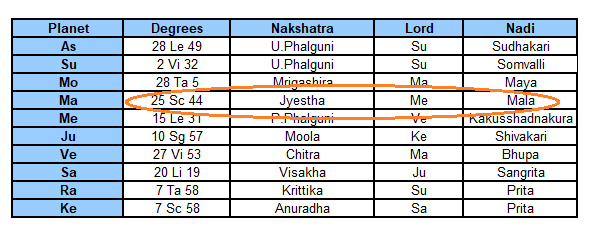
Fixing The Degree
Suppose we have to find the nadi ansha of mars situated in chart at the degree 25 Sc 44. Correspond this degree, which is 25deg 44′ in table number one. In this table, 25 degree 44′ falls under nadi serial number 131 (upto 26.00′.00″).
So, first step is over after finding nadi serial 131.
Before we search nadi serial 131 in table two, we have to check the sign where mars is placed. This is placed in scorpio sign. Scorpio is a fixed sign category. So, we will count nadi serial from the fixed sign column, which begins with number 150 as per fixed sign table 2.
In any fixed sign, first nadi ansha start with serial 150 in reverse order till the end of serial n.1
Here, you will find the name of nadi ansha of serial 131 is “mala” Check the table 2 for detail.
In similar way, we can find the starting degree of a house under study. Refer to bhav chalit chart as below. This is very important because nadi ansha or this degree can tell us which planet is having hold on this house.
Vasuda nadi is the first nadi in the beginning of aries moveable rashi. This is from 0 degr to 0 deg 12 minutes, the 2nd nadi ansha is from 0 deg 12 minutes to 0 deg 24 minutes and so on till the 150th nadi ansha is from 29 deg 48 minutes to 30 deg.
Next, In taurus, a fixed rashi, 1st nadi ansha of vasuda is from 29 deg 48 minutes to 30 deg, the 2nd one from 29 deg 36 minutes to 29 deg 48 minutes and so on till the last 150th nadi ansha is from 0 deg to 0 deg 12 minutes.
In gemini dual rashi, the 1st nadi ansha of vasuda is from the middle 15 deg to 15 deg 12 minutes, the 2nd one from 15 deg 12 minutes to 15 deg 24 minutes and so on till the 75th nadi ansha is from 29 deg 48 minutes to 30 deg and then the 76th nadi ansha starts from the beginning of 0 deg to 0 deg 12 minutes, the 77th from 0 deg 12 minutes to 0 deg 24 minutes and so on till the 150th one is from 14 deg 48 minutes to 15 deg.
Thus it can be seen that 1st nadi ansha in aries, the 150th nadi ansha in taurus and the 76th nadi ansha in gemini are the same. This will be illustrated in next table. First nadi vasudha, will fall in all signs of a chart at different degrees and with different characteristics. This may give better result for cancer sign while in leo sign it may not. Result of all nadi ansha are not same for a single sign. I will try to explain later with their properties and results.
Basic theory of nadi ansha is the starting degree of any house, which is the important factor for the result of this house. The planets which are strong for the beginning nadi of a house has influence on that house. All this depends on bhav chalit accuracy and integrating correct swodaya kaal in it. Other bhav chalit systems, the central houses like 1st, 4th, 7th and 10th houses has equal degrees like in KAS system. This fits perfect and has no difference as compared to other bhav chalit system. The main difference is lies on the factor when those systems are not following sawodaya kaal of the rashi belonging to the houses like 2nd, 3rd, 5th, 6th, 8th, 9th, 11th and 12th. In their system, division of rashi is made equal for second and third houses and respective opposite houses like 8th and 9th houses. Same pattern is followed for 5th and 6th house versus 11th and 12th houses which is incorrect. As such, we can not expect accurate strength of planets in a particular nadi in those system. Only KAS is widely trusted. Refer to the following examples for more detail how to apply bhav chalit taking a example chart.
LAGNA NADI
Lagna nadi is very important. This is nothing but starting degree of lagna which falls in all 16 D charts. This degree or nadi tells about nature, individuality, and personality of a person. It is different than nine sectors, as we consider for lagna, sun and moon. In other words, lagna nadi will give us deep inside inner nature and reflects so many things about a person’s life. The sign lords of all sixteen divisional charts, where this degree falls, ascertain their strength in lagna nadi. Suppose, if any planet is strong like Jupiter or Venus in a nadi, this purely means jupiter or venus are in uccha, mooltrikona or in own sign in more divisional charts. So our KAS system is not different than vedic astrology system. But this part is very sensitive, used for birth time rectification. One thing should be always kept in mind that powers of nadi’s are different in different signs thus these will have entirely unique qualities there and calculated on the basis of nadi’s net power. Like if a planet is in Prabha Nadi is at deg 3.23 i.e in Aries, Cancer, Libra or Cap sign will have different quality when same planet is placed in same nadi at the deg 26.35 in Taurus, Leo, Scorpio and Aquarius sign. Though the nadi is same but have different characteristics in different placement. [ READ MORE…]
IMPORTANCE OF BHAV CHALIT
There are many systems having their own theories how to calculate Bhav Chalit and fixing degree of each house. Some systems use equal degrees between first to fourth house ( 2nd, 3rd house) taking equal degrees of opposite houses (for 8th and 9th houses) . This calculation is not correct. Krushna’s Ashtakavarga System sheds broader light and provide insight on this ancient knowledge. How this can be correct when each sign has a different Sawodaya kaal ? Similarly, taking first house to tenth house in clockwise direction, there will be twelfth and eleventh houses. Opposite houses of these are fifth and sixth houses. Degrees of these two will be different as per their respective sawodaya kaal. For example, eleventh house degree should be different than it’s opposite sign fifth house, just because, every house has different sawodaya kaal. I will explain further but keep in mind this only for quality and quantum and not for timing. I will explain calculation part in my two videos how to cast a Bhav Chalit chart plus application of nadi ansha.
What Is Sawodaya Kaal
Sawodaya kaal is transit time of a sign at a particular place or location. Suppose you cast a chart at your town where aries lagna begins with 0 deg at 6am. Assume this aries lagna ends at 8.04 am. After ending aries lagna, taurus will begin. Now this total time of 124 minutes (2 hours 4 minutes) of aries sign is called sawodaya kaal. This is for your particular place. Likewise, every rashi(sign) has different sawodaya kaal in natal chart. Different cities will be having different sawodaya kaal for the same rashi. For example, the above aries sign will be having different sawodaya kaal for amritsar city in punjab state and for chennai in tamil nadu state.
HORA CHART – DIN-MAAN AND RATRI-MAAN
For a sign, time to travel 30 degrees is equal to..?? In fact this is around 27 degrees and not 30 degrees. Our earth has a constant speed and it does not change. But it is tilted 23 degrees on it’s axis, so sawodaya kaal of each sign is different. From sunrise to sunset, total sawodaya kaal of all signs is called “dinmaan”. Similarly, total sawodaya kaal of all signs in night time is called “ratrimaan” . Now adding up both are called “aaho-ratro” . Ignoring “aa” and “tro” from this word is called HORA, which we used as a hora chart taking sun and moon. So this is basically full dinmaan – time from one sunrise to next sunrise. In hora chart, the moon portion is fourth house. This will signify our net assets, the second house. Hora of sun relates to third house, which will show prakaram of a person. This chart will be D-2, reflecting net assets and prakaram. In hora, no other planets are involved except sun and moon where as in trimsansha D-30 rest of five planets are involved. Hora is D-2 chart which signifies net assets and prakaram.
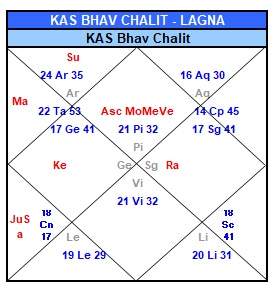
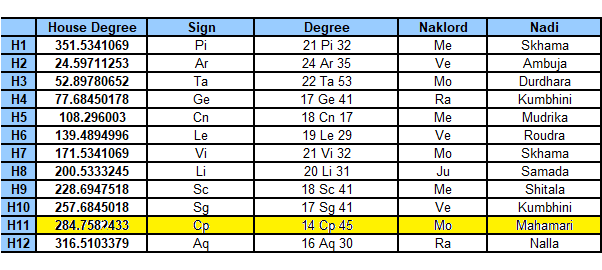
RELATIONSHIP OF SIGNS OF CHARAN (PADA) AND NAVAMSA
As we all know, usually we take 27 nakshatras or constellations and every nakshatra measures 13.20′ (13 degrees and 20 minutes). Each nakshatra is divided into 4 parts of 3.20’ (3 degrees and 20 minutes). These parts are called charan or pada.
Each charan has the characteristics of a sign starting with Aries.
In each nakshatra there are 4 charan. Therefore, in 3 nakshatras we have 12 charan. Because each charan represents a sign of the zodiac in a group of 3 nakshatras we find the entire zodiac in the form of charan-signs.
Now each sign covers 2 � nakshatras. So, total is 4 + 4 + 1 = 9 charan in a sign.
The navamsa is the 1/9 division of the zodiac. Therefore, there is connection between the charan and the navamsa. The connection is very simple. If a planet is in the charan of Aries, then it is in the navamsa in Aries. If it is in the charan of Taurus it is in the navamsa in Taurus and so on.
Therefore, the navamsa signs and the signs of the charan are the same.
This charan, we call D-9 ansha or nav-ansha. So, in which charan, karaka of any house is situated, is called karakansha.
That why, we say navamsa is the chart of the soul. It gives information about the state of the soul and thus of the inner life of the person. Therefore, it can be said that the signs of the charan give information about the soul of a person.
If the rashi contains information about in which charan, planets are located, there is no need for a separate calculation of the navamsa. Navamsa signs and charan signs are the same.
EXAMPLE CHART – NAVAMSA
